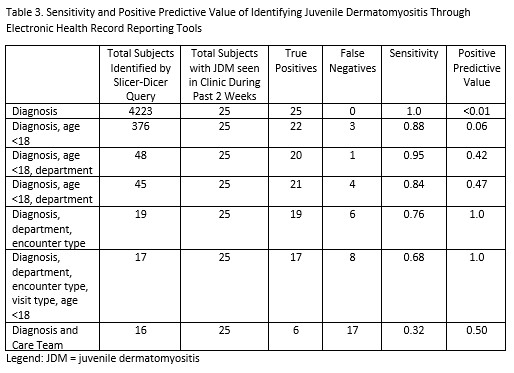Session Information
Date: Thursday, March 30, 2023
Title: Poster Breakout 2 - JIA & Uveitis: Genetics, Clinical & Therapeutic Aspects
Session Type: Breakout Session
Session Time: 5:10PM-5:40PM
Background/Purpose: Research teams spend hours manually searching the electronic health records (EHRs) to identify potential candidates eligible for recruitment to the Childhood Arthritis and Rheumatology Research Alliance (CARRA) Registry. There are multiple existing tools, including self-service reporting tools and more detailed data extraction methods, which may increase the efficiency of eligible subject identification. This study aims to build a predictive electronic algorithm to identify children with rheumatic disease using electronic health record data.
Methods: Five diverse clinical sites (Duke, Mayo, Nationwide Childrens, Stanford, Vanderbilt) evaluated currently available EHR reporting functionality and developed self-service queries. All sites used the same electronic health record vendor (Epic Systems Corporation). Available shared reporting tools were identified. Queries were created and evaluated for their sensitivity and positive predictive value of identifying children with juvenile arthritis (ICD10-CM M08.*, M35.7), lupus and associated conditions (M32.*, L93.*, H01.12, M35.*), and dermatomyositis (M33.*). The observation period was a convenience sample limited to two weeks duration; clinic schedules were reviewed to validate patients with these diagnosis, and were compared to the output of the queries. Descriptive statistics were used.
Results: Three automated extraction tools were identified. Clarity reports, which can pull nearly all EHR data with associated complex data linkages from Epics back-end database, requires custom programming and were not available without significant funding at most centers. Two other tools, Slicer-Dicer and Reporting Workbench, were available without cost, on-demand, and were readily available to be run by end-users. Slicer-Dicer was the easiest to configure and was further evaluated (Tables). The highest performing queries to identify patients with rheumatic disease included limiting queries by diagnosis, department, and encounter type. Although additional discrete data elements can be configured to report in Slicer-Dicer, these require access to specialized programming environments.
Conclusion: Although highly detailed reports can include additional variables and output, end-user usability was a key factor to configure and utilize on-demand and readily available reporting tools. Queries with high sensitivity and positive predictive value across all conditions included diagnosis, department, and encounter criteria. Enabling availability of additional discrete data elements could likely improve identification of children with rheumatic disease. Integration of reporting tools into research screening and recruitment workflows are needed.
 Sensitivity and Positive Predictive Value of Identifying Juvenile Idiopathic Arthritis Through Electronic Health Record Reporting Tools
Sensitivity and Positive Predictive Value of Identifying Juvenile Idiopathic Arthritis Through Electronic Health Record Reporting Tools
 Sensitivity and Positive Predictive Value of Identifying Lupus and Associated Conditions Through Electronic Health Record Reporting Tools
Sensitivity and Positive Predictive Value of Identifying Lupus and Associated Conditions Through Electronic Health Record Reporting Tools
 Sensitivity and Positive Predictive Value of Identifying Juvenile Dermatomyositis Through Electronic Health Record Reporting Tools
Sensitivity and Positive Predictive Value of Identifying Juvenile Dermatomyositis Through Electronic Health Record Reporting Tools
To cite this abstract in AMA style:
Taxter A, Basiaga M, Pooni R, Pinotti C, Buckley L, Investigators C. Using the Electronic Health Record to Identify Subjects with Rheumatic Disease [abstract]. Arthritis Rheumatol. 2023; 75 (suppl 4). https://acrabstracts.org/abstract/using-the-electronic-health-record-to-identify-subjects-with-rheumatic-disease/. Accessed .« Back to 2023 Pediatric Rheumatology Symposium
ACR Meeting Abstracts - https://acrabstracts.org/abstract/using-the-electronic-health-record-to-identify-subjects-with-rheumatic-disease/
